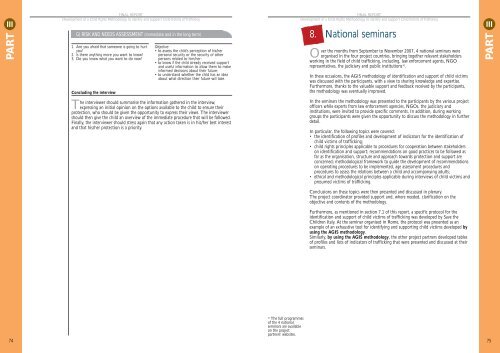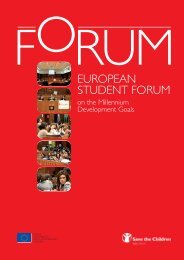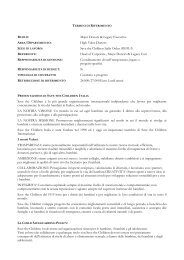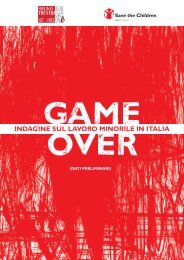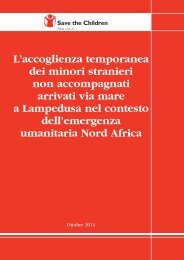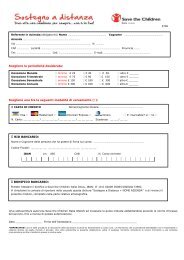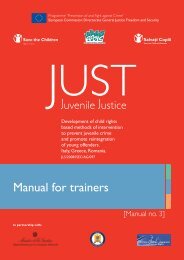IIIPART<strong>FINAL</strong> <strong>REPORT</strong>Development of a Child Rights Methodology to Identify and Support Child Victims of TraffickingMETHODOLOGICALFRAMEWORK No. 9Table of ProceduresIN-DEPTH INTERVIEW ON THE CHILD’S EXPERIENCEFirst stepThe interviewer will start <strong>the</strong> interview, in <strong>the</strong> respect of <strong>the</strong> indications presented in<strong>the</strong> above tables. He/she will present himself/herself to <strong>the</strong> child and will discussabout his/her experience in interviewing children. He/she will also introduce o<strong>the</strong>rprofessionals who may be present in <strong>the</strong> course of <strong>the</strong> interview.Interviewing <strong>the</strong> childThe interviewer is aware of <strong>the</strong> indicators of identification informing <strong>the</strong> presumptionthat <strong>the</strong> child is a victim of trafficking. He/she also has ga<strong>the</strong>red <strong>the</strong> opinion ofo<strong>the</strong>r professionals that have come in contact with <strong>the</strong> child.A checklist of questions is available, selected on <strong>the</strong> basis of an individual case assessment.If personal data and social history information was not collected in <strong>the</strong> initial interviewor when <strong>the</strong> child was detected, <strong>the</strong> interviewer will seek to obtain it at this stage.Specific questions will be asked in relation to <strong>the</strong> indicators already identified. Fur<strong>the</strong>rquestions will be asked to gain additional knowledge on topics raised in <strong>the</strong> interview by<strong>the</strong> child.If it is in <strong>the</strong> child’s best interest, <strong>the</strong> interviewer will focus <strong>the</strong> discussion only on alimited number of topics and will postpone fur<strong>the</strong>r questioning.Topics to be coveredThis table describes what professionals should do in <strong>the</strong> differentsteps of <strong>the</strong> interview and also provide a list of topics to becovered and examples of checklists.Indications given shall be considered with flexibility. Nationalstakeholders shall take into consideration and add any elementthat although not suggested under <strong>the</strong> AGIS methodology, mightbe relevant to include in <strong>the</strong>ir national or local context.<strong>FINAL</strong> <strong>REPORT</strong>Development of a Child Rights Methodology to Identify and Support Child Victims of Trafficking3. How much money do you earn daily? Haveyou been asked to reach a certain dailyamount?4. Do you keep <strong>the</strong> money for yourself or doyou give it to someone else?5. Can you describe your working day?ProstitutionExample of checklist:1. How long have you been conducting thisactivity?2. Do you follow any directions on how toconduct your work?3. Can you choose your clients?4. How do you ensure you earn enough to takecare of your needs?5. Can you describe your working day?Illegal activitiesExample of checklist:1. How long have you been conducting thisactivity?2. Do you follow any directions regarding <strong>the</strong>activity to be conducted?3. Have you been travelling within <strong>the</strong> country?4. Who are <strong>the</strong> persons you refer to?5. Is <strong>the</strong>re any group you belong to?6. Have you reached any agreement withmembers of <strong>the</strong>se groups - sharing ofresponsibilities, management of income...7. Have you ever been stopped by <strong>the</strong> policebecause of your activities?8. Is <strong>the</strong>re any person you go to if you needsupport?9. What do you do in your spare time?D) THREATS AND COERCIONto <strong>the</strong> location where <strong>the</strong> activity isconducted, money <strong>the</strong> child is forced to raise,management of <strong>the</strong> income obtained.Objective:• to ga<strong>the</strong>r information on <strong>the</strong> activity.Objective:• to ga<strong>the</strong>r information on <strong>the</strong> activity, transferwithin <strong>the</strong> national territory, relations withgroups (including criminal groups), relationswith o<strong>the</strong>r persons, involvement in <strong>the</strong> penalcircuit.IIIPARTA) PERSONAL SITUATION BEFORE AND DURING ENTRY TO THE COUNTRY,AND IN THE COUNTRY OF DESTINATIONExample of checklist:1. Did your family know you were travelling?Did someone help you arrange your travel?2. How long did <strong>the</strong> journey take? Where wereyou during that time?3. Did you have enough to eat and drink?4. Who did you travel with?Objective:• to ga<strong>the</strong>r information on <strong>the</strong> country and areaof origin, family, reasons of <strong>the</strong> child’sdeparture, living conditions during <strong>the</strong> journey,persons involved;• to identify elements to classify <strong>the</strong> situation astrafficking.Example of checklist:1. Did someone ask you to perform thisactivity? Who was it and why did <strong>the</strong>y askyou?2. Where were you contacted? Were anypromises made to you?3. Have you received any training prior toperforming <strong>the</strong> activity?4. Can you move freely? Are <strong>the</strong>re any rules youhave to respect?5. Are you scared of anything or anyone?6. What would you like to do in this situation?Objective:• where possible, to follow up on informationalready given by <strong>the</strong> child and ga<strong>the</strong>rinformation on forms of recruitment,(including persons involved, informationreceived) training received, physical orpsychological threats, agreements reached with<strong>the</strong> exploiter, personal freedom, reaction to<strong>the</strong> described situation, relations with <strong>the</strong>exploiter or any o<strong>the</strong>r person mentioned,concerns, threats of reprisal.B) LIVING CONDITIONSE) PERCEPTION OF THE SITUATIONExample of checklist:1. Do you have any family in <strong>the</strong> country? Who?2. Do you pay for your accommodation? Whatis it like?3. How much money do you earn every week?Is it enough?4. What do you do during <strong>the</strong> day?Objective:• to ga<strong>the</strong>r information on living conditions in<strong>the</strong> country of destination;(persons involved, accommodation, dailyactivities conducted, network/s providingsupport to <strong>the</strong> child - if at all).1. What is it like to beg? Objective:• to ga<strong>the</strong>r information on how <strong>the</strong> childperceives his/her situation.F) FUTURE PLANS AND EXPECTATIONSC) MEANS OF SUBSISTENCE (availability of economic resources)Begging1. What do your parents think of your situation?What would <strong>the</strong>y like for you to do? Is thatwhat you want to do?Objective:• to ga<strong>the</strong>r information on <strong>the</strong> child’sexpectations regarding his/her future (incl.feeling that an agreement has to be respected,involvement of relatives.72Example of checklist:1. Since when have you been involved in begging?2. Is <strong>the</strong>re any adult you meet daily in this activity?Objective:• to ga<strong>the</strong>r information on <strong>the</strong> duration of <strong>the</strong>activity, persons involved, means of transport73
IIIPART<strong>FINAL</strong> <strong>REPORT</strong>Development of a Child Rights Methodology to Identify and Support Child Victims of TraffickingG) RISK AND NEEDS ASSESSMENT (immediate and in <strong>the</strong> long term)1. Are you afraid that someone is going to hurtyou?2. Is <strong>the</strong>re anything more you want to know?3. Do you know what you want to do now?Objective:• to assess <strong>the</strong> child’s perception of his/herpersonal security or <strong>the</strong> security of o<strong>the</strong>rpersons related to him/her;• to know if <strong>the</strong> child already received supportand useful information to allow <strong>the</strong>m to makeinformed decisions about <strong>the</strong>ir future;• to understand whe<strong>the</strong>r <strong>the</strong> child has an ideaabout what direction <strong>the</strong>ir future will take.Concluding <strong>the</strong> interviewThe interviewer should summarise <strong>the</strong> information ga<strong>the</strong>red in <strong>the</strong> interview,expressing an initial opinion on <strong>the</strong> options available to <strong>the</strong> child to ensure <strong>the</strong>irprotection, who should be given <strong>the</strong> opportunity to express <strong>the</strong>ir views. The interviewershould <strong>the</strong>n give <strong>the</strong> child an overview of <strong>the</strong> immediate procedure that will be followed.Finally, <strong>the</strong> interviewer should stress again that any action taken is in his/her best interestand that his/her protection is a priority.<strong>FINAL</strong> <strong>REPORT</strong>Development of a Child Rights Methodology to Identify and Support Child Victims of Trafficking8. National seminarsOver <strong>the</strong> months from September to November 2007, 4 national seminars wereorganised in <strong>the</strong> four project countries, bringing toge<strong>the</strong>r relevant stakeholdersworking in <strong>the</strong> field of child trafficking, including, law enforcement agents, NGOrepresentatives, <strong>the</strong> judiciary and public institutions 41 .In <strong>the</strong>se occasions, <strong>the</strong> AGIS methodology of identification and support of child victimswas discussed with <strong>the</strong> participants, with a view to sharing knowledge and expertise.Fur<strong>the</strong>rmore, thanks to <strong>the</strong> valuable support and feedback received by <strong>the</strong> participants,<strong>the</strong> methodology was eventually improved.In <strong>the</strong> seminars <strong>the</strong> methodology was presented to <strong>the</strong> participants by <strong>the</strong> various projectofficers while experts from law enforcement agencies, NGOs, <strong>the</strong> judiciary andinstitutions, were invited to provide specific comments. In addition, during workinggroups <strong>the</strong> participants were given <strong>the</strong> opportunity to discuss <strong>the</strong> methodology in fur<strong>the</strong>rdetail.In particular, <strong>the</strong> following topics were covered:• <strong>the</strong> identification of profiles and development of indicators for <strong>the</strong> identification ofchild victims of trafficking;• child rights principles applicable to procedures for cooperation between stakeholderson identification and support; recommendations on good practices to be followed asfar as <strong>the</strong> organisation, structure and approach towards protection and support areconcerned; methodological framework to guide <strong>the</strong> development of recommendationson operating procedures to be implemented, age assessment procedures andprocedures to assess <strong>the</strong> relations between a child and accompanying adults;• ethical and methodological principles applicable during interviews of child victims andpresumed victims of trafficking.IIIPARTConclusions on <strong>the</strong>se topics were <strong>the</strong>n presented and discussed in plenary.The project coordinator provided support and, where needed, clarification on <strong>the</strong>objective and contents of <strong>the</strong> methodology.Fur<strong>the</strong>rmore, as mentioned in section 7.1 of this report, a specific protocol for <strong>the</strong>identification and support of child victims of trafficking was developed by <strong>Save</strong> <strong>the</strong><strong>Children</strong> Italy. At <strong>the</strong> seminar organised in Rome, <strong>the</strong> protocol was presented as anexample of an exhaustive tool for identifying and supporting child victims developed byusing <strong>the</strong> AGIS methodology.Similarly, by using <strong>the</strong> AGIS methodology, <strong>the</strong> o<strong>the</strong>r project partners developed tablesof profiles and lists of indicators of trafficking that were presented and discussed at <strong>the</strong>irseminars.7441The full programmesof <strong>the</strong> 4 nationalseminars are availableon <strong>the</strong> projectpartners’ websites.75


